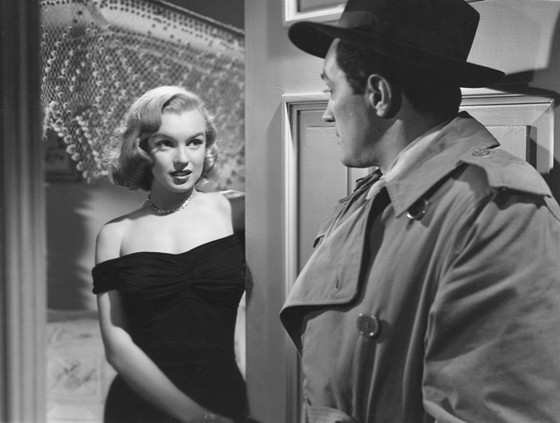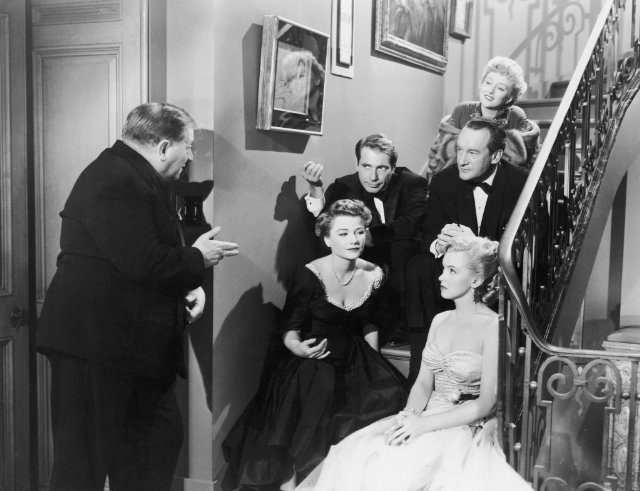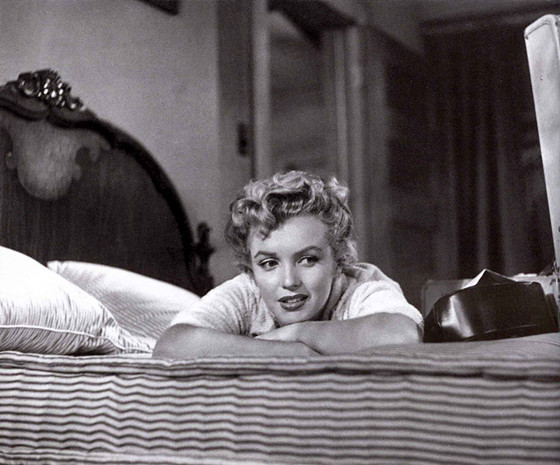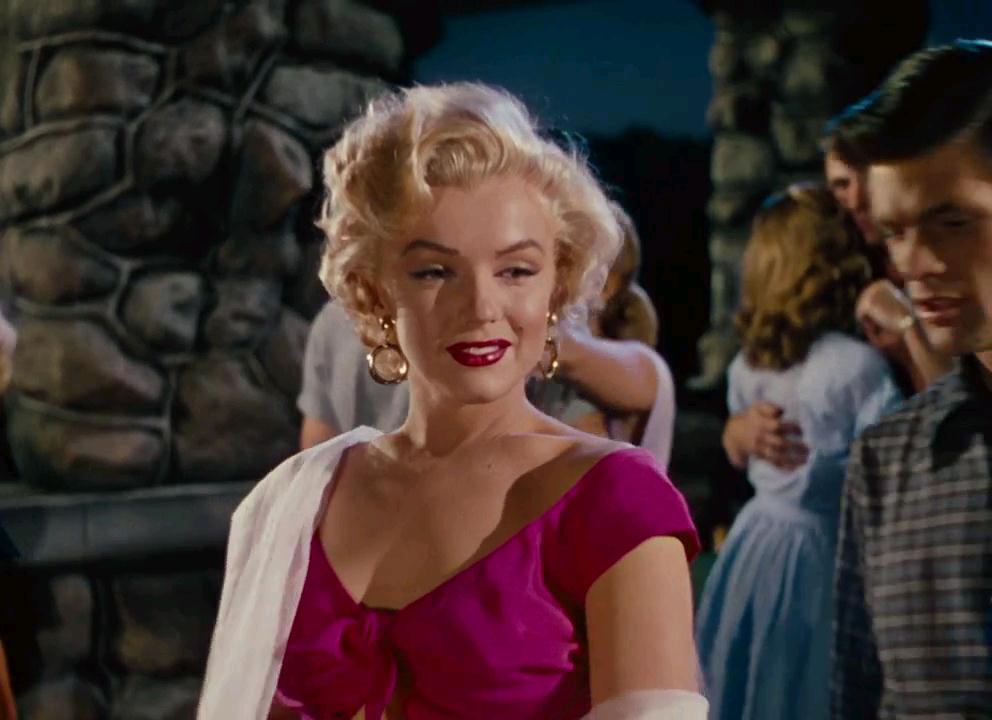There will never be another like Marilyn Monroe. Born Norma Jeane Mortenson in 1926, Marilyn started her career modelling, followed with tiny, often not speaking parts, in films for 20th Century Fox and Columbia Pictures. But it wasn’t until her appearance in John Huston’s The Asphalt Jungle in 1950 for Metro-Goldwyn-Mayer that people started to take note of her.
Her profile only increased when old nudie pictures of a young Monroe surfaced, which in turn led to her gracing the cover of the first edition of Playboy magazine and becoming the first ever Playmate of the Month. As a result, her film roles became bigger and in 1952 she really broke through with Monkey Business, a comedy which starred Cary Grant and Ginger Rogers and the first film in which Monroe would appear with her trademark platinum blonde hair. From there on in her fame skyrocketed and she turned into the sex symbol she will always be remembered for, dominating most the fifties with her screen and media presence.
By the late fifties fame and personal problems would start taking their toll on the actress, before her untimely death in 1962 at the age of 36. But in the decade preceding her passing, Monroe left a legacy of films which would make her into a true cultural icon, one of the most mythologised actresses ever and the ultimate American sex bomb. There will never be another like Marilyn Monroe.
10. Asphalt Jungle (John Huston, 1950)
Whilst The Asphalt Jungle is by no means Marilyn Monroe’s first appearance on the silver screen and even though she had larger roles before the one here, this is the first noteworthy movie the rising starlet appeared in. It is in fact one of the best films she appeared in although that would be skewing things as this is hardly a Marilyn Monroe movie. Based on the novel of the same name by W. R. Burnett, The Asphalt Jungle is a classic heist flick in which Monroe had a minor though noteworthy part as the young mistress of the mastermind behind the crime.
Master criminal Erwin “Doc” Riedenschneider (Sam Jaffe) has just been released from prison after a seven year stretch and immediately gets involved in a planned jewellery heist by crooked lawyer Alonzo Emmerich (Louis Calhern) . Doc assembles a team, which includes a hooligan named Dix (Sterling Hayden), a driver called Gus(James Whitmore) and professional safecracker Louis Ciavelli (Anthony Caruso). The job is meticulously planned and executed but on their way out Louis get shot in the belly when Dix slugs a security guard whose gun drops and goes off accidentally. From there on in, the team’s perfect plan slowly starts to unravel as the police close in and the men start double-crossing each other.
A classic film noir with a fantastic heist sequence, which takes up about 11 minutes of screen time, The Asphalt Jungle is a suspenseful and gritty caper. Monroe wasn’t famous at the time of its release and consequently not mentioned on the film’s original posters but this would all soon change and later, when the film would get re-released, she would be prominently featured on the advertising amongst the other stars. Beautifully shot in moody black and white and featuring a great cast, the film managed to pick up four Academy Award nominations for Best Director, Supporting Actor, Adapted Screenplay and Cinematography.
9. All About Eve (Joseph L. Mankiewicz, 1950)
The Asphalt Jungle got Monroe enough attention to be cast in another major production: Joseph L. Mankiewicz’s All About Eve, starring Bette Davis, Anne Baxter and George Sanders. Once again, this might also be one of the best films the rising starlet ever appeared in although that certainly didn’t have much to do with the minor part Monroe played. Basically appearing in one scene at a party as a blonde who is trying to make it on Broadway, she is famously introduced in the movie by Sanders as “a graduate of the Copacabana school of dramatic arts”.
The film follows Eve Harrington (Baxter) as she works her way into the life of aging Broadway star Margo Channing (Davis) by initially becoming her personal assistant, after expressing her admiration for the star and telling her her sad life story. But not before long it becomes apparent that Eve is just using Margo and those around her to further her own agenda, threatening Margo’s career and personal life in the process.
Whilst Monroe once again had a tiny role in All About Eve, this performance and the one before it in The Asphalt Jungle garnered her enough attention to make the jump to larger supporting roles. It didn’t hurt that All About Eve was a resounding success, winning six Academy Awards that year, including Best Film, Best Director, Best Screenplay and Best Actor for George Sanders.
8. Clash By Night (Fritz Lang, 1952)
After having been noticed in small roles in the aforementioned films, Monroe’s star was on the rise and whilst still playing supporting roles, her screen time and fame steadily increased. Monroe’s best film during the years between those initial bit parts and her true rise to fame and leading roles has to be Fritz Lang’s Clash By Night, the first film in which she was credited before the movie’s title in the opening credits. The fact that her old nudie pics calendar also surfaced during the production of this film, only increased her exposure and notoriety.
The film tells the story of Mae (Barbara Stanwyck), who after a ten year period of absence, comes back home to live with her brother Joe, who is seeing factory girl Peggy (Monroe). Soon after her arrival she meets Jerry, a local fisherman, and starts dating him, which leads to marriage and a child despite the fact that Mae doesn’t really love Jerry and is only seeking stability. Meanwhile Joerrys friend Earl (Robert Ryan) starts making moves on Mae and soon the two are having affair, causing a rift between the two former friends.
A melodrama with some noir elements, Clash By Night is an aptly directed film by master filmmaker Fritz Lang. The last small role by Monroe you’ll find on this list before she would become a star, she nonetheless was credited with much of the success of the movie due to the buzz surrounding her at the time. She would soon make the jump to leading roles in Don’t Bother To Knock and finally making it into the big time with the next entry on this list: Monkey Business.
7. Monkey Business (Howard Hawks, 1952)
The first film on this list that can be truly called a Marilyn Monroe movie, even though she did not have a lead role in it, Monkey Business truly kick-started the Marilyn Monroe craze. The first film in which she would appear with her signature platinum blonde hair, this screwball comedy, which was headlined by Cary Grant and Ginger Rogers, was a sizeable hit and even though Monroe didn’t have a whole lot to do, simply playing a secretary, she nonetheless managed to stand out and cause quite a stir.
The story is as silly as screwball comedies tend to get. Dr. Barnaby Fulton (Grant) is an absent minded professor who is trying to come up with a concoction that will restore one’s youth. Try as he may, he can’t seem to find the right formula but when a lab chimpanzee is let loose, the animal manages to mix chemicals in just the right amounts to actually create the elixir of youth. Unknowingly Dr. Fulton drinks some and spontaneously regresses to his twenties. As a result he spends the day with his boss’ secretary (Monroe) which greatly upsets his wife (Rogers). But when she also drinks some of the elixir, she turns out to act even worse and soon everybody seems under the potion’s spell.
A goofy comedy, if ever there was one, and also quite reminiscent of Hawk’s earlier Bringing Up Baby, Monkey Business sealed the deal and turned Monroe into a star. The following year she would capitalise on this new found stardom and truly become the sex symbol we still know her as today with the production of not one or two, but three iconic films in her repertoire, one of which would see her join forces once again with Howard Hawks.
6. Niagara (Henry Hathaway, 1953)
1953 was without a doubt the year of Marilyn Monroe. It the year she finally became a full blown star and Niagara was the first film out of three to be released that year to do it. Giving her first billing for the first time in her life, this tense Technicolor film noir is the closest Monroe has ever been to a Hitchcock-like thriller in her career. It also proved one of 20th Century Fox’s biggest box-office draws that year.
The film tells the story of two couples. Polly (Jean Peters) and Ray Cutler (Casey Adams) are on their honeymoon and arrive at Niagara Falls, only to find their cottage occupied by another couple, George Loomis (Joseph Cotten) and his wife Rose (Monroe). Soon enough Polly finds out that Rose is having an affair with Patrick (Richard Allan) and Rose seems to flaunt her sexuality constantly, which causes her husband to have violent episodes.
It’s all part of the plan though as Rose and Patrick want to kill George and people to consequently think that his violent temper might have been the cause of some sort of accident. But things don’t go as planned as George outwits the lovers and ends up killing Patrick instead. From there on in things go from bad to worse as George also wants to kill his wife in revenge for her cheating and conniving ways. But before he is able to do so, Polly runs into him, discovering that he is still very much alive and informing the police of what’s going on.
Niagara wasn’t a critical darling at the time but that didn’t stop the audience from turning up in droves. The film is also noteworthy as it allowed Marilyn got to extend her acting chops a bit since her role here required her to be a scheming femme fatale instead of the vulnerable dumb blonde she had basically always been asked to play before. Unfortunately for her, the critics didn’t praise her for her performance and the audience ultimately did not come to see her act. They just came to see the gorgeous natural beauty in the film, both Niagara’s and Monroe’s.




